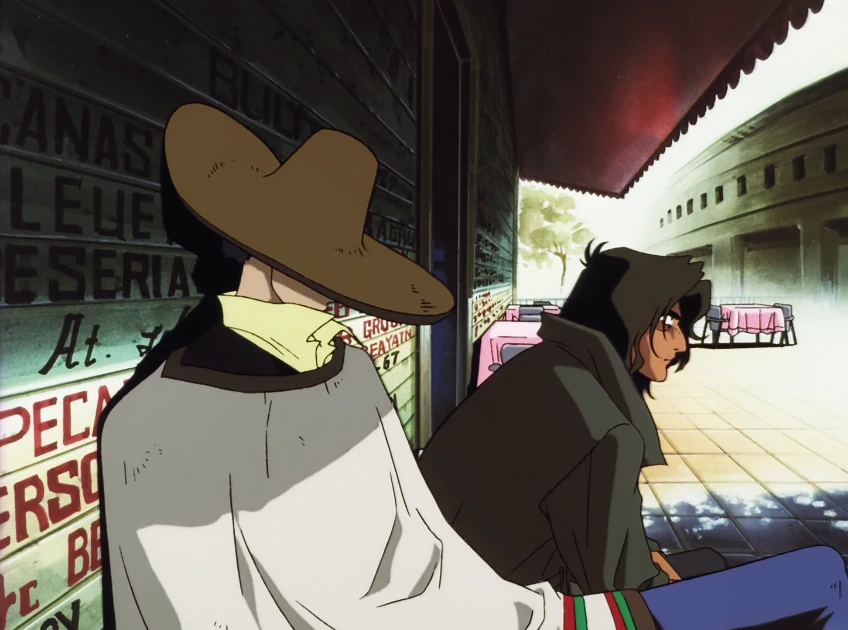Let’s talk jazz.
You’ve most likely heard by now, but in just under a month, Netflix is going to be setting loose a live action adaptation of Cowboy Bebop, an anime series that…well, let’s just say the only real debate over the show is whether it’s the best anime of all time or merely one of the best anime of all time.
But, if anime isn’t a world you’re familiar with, you might be wondering why a series that premiered all the way back in 1998 is still held in such high esteem more than 20 years after it first aired. Fortunately, Cowboy Bebop wastes no time in letting you know exactly what you’re in for: its first “session”, as the show calls its episodes, “Asteroid Blues” sets up just about everything great about the series right from the start, from its uniquely stylish presentation and mix of influences to its iconic cast of characters—all while telling a touchingly human story of trying to escape your past and start over.
For starters, let’s talk about those opening credits—or OP, as they’re more commonly known. Truth be told, we could easily spend all day just talking about the opening credits, as they’re one of the most iconic aspects of the series that perfectly introduces us to Bebop’s style and mood.
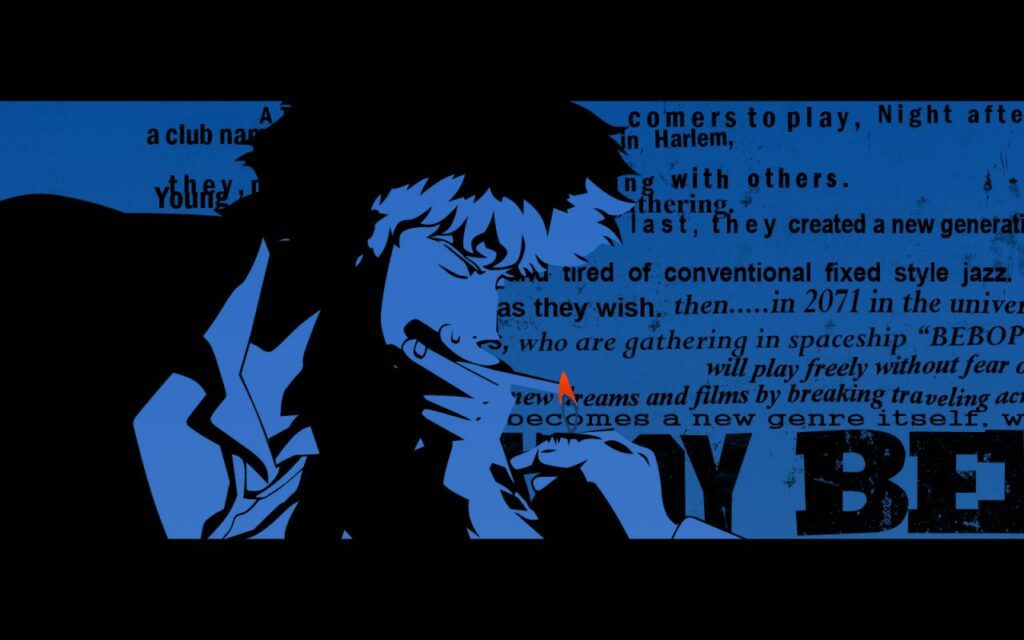
First, the music. Unlike the J-pop tunes that were common at the time, the opening song “Tank!” is a big band-style jazz tune that sets the tone. The opening brass sting hits you like a train and grabs your attention before giving way to a slick double bass riff.
Then, as the drums pick up, we get an invitation from an unseen voice: “I think it’s time to blow this scene…get everybody and the stuff together…okay: three, two, one, let’s jam.” Finally, the brass kicks back in, carrying us through the rest of the title before the whole thing culminates in an extended, freeform solo on an alto sax. It’s bold, loud, different, and cool. Timeless cool. Old school cool. Miles Davis’s Birth of the Cool cool.
Visually, it’s just as striking, more Saul Bass than Sailor Moon. Characters are often exclusively shown in silhouette against bold blocks of color, while the imagery mixed throughout shows off the major influences that are blended to create the show’s idiosyncratic flavor: martial arts, film noir, sci-fi, westerns, and free jazz, rendered in ways that blur the lines between the each of them—my personal favorite touch is how the spaceships’ weapons are shown in close-ups that make them look more like a cowboy’s six-shooter than anything out of Star Wars or Battlestar Galactica. The show’s title is frequently found in the background as well, along with a manifesto of sorts that tells the story of a group of musicians seeking to break out of “conventional fixed-style jazz.”
At the time, there was nothing else like Bebop‘s OP, and before we’ve even seen any of the episode itself—beyond a brief flashback sequence—it’s made crystal clear that this isn’t going to be anything like any other anime you would have seen at the time.
As for the episode itself, “Asteroid Blues” serves as a perfect starting point for the series, setting up many of the recurring themes and tropes that would remain consistent throughout the show’s 26-episode run.
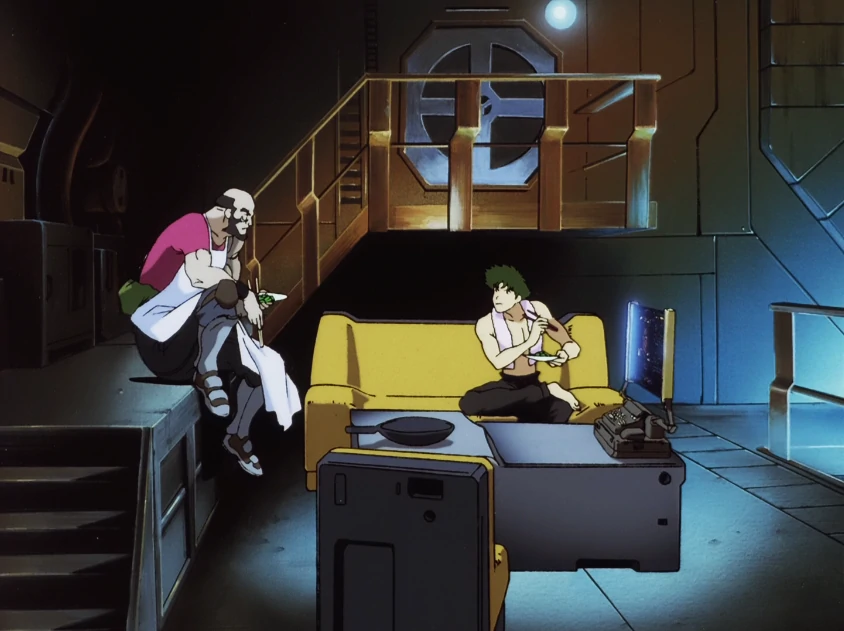
First off, there are our two main characters: Spike Spiegel and Jet Black—Faye, Ein, and Ed don’t come until later. The first couple of scenes are entirely focused on these two, setting up a solid foundation for understanding their relationship and dynamic. When we first join the pair of them on the Bebop, Spike is practicing martial arts in the dark while Jet is cooking dinner for the two; when they reconvene to eat and discuss their next job, it reinforces that Spike is the younger, more hotheaded one while Jet is the older and wiser of the two.
Turns out, Jet’s “special” of bell peppers and beef is missing the whole “beef” part, which Spike takes as an almost personal offense before Jet grimly reminds him that the two of them are broke—the state in which we almost always find the crew of the Bebop, no matter how many bounties they bring in. This time, Jet tells Spike (and us), the million woolong (the show’s currency) reward from the last job was eaten up by “the repair bill from that cruiser you wrecked, and that one from the shop you trashed, and the medical bill from the cop you injured…”
The second major element this episode establishes is the show’s structure. The vast majority of Bebop‘s 26 episodes are self-contained stories, and “Asteroid Blues” is no different, focusing on the crew pursuing a particular bounty or job to try and earn a living—the closest thing to an overarching storyline isn’t even introduced until Episode 5, just shy of a fifth of the way through the entire series, and then gets put on the back burner again until Episode 13.
Instead, Bebop chooses to spend most of its time focusing on developing the show’s main cast of characters—exploring their pasts, relationships, and internal conflicts—while taking advantage of its structure to pit the crew against an expansive and eccentric menagerie of bounties. The target of “Asteroid Blues” is one Asimov Solensan, who had just betrayed his own men in a shootout between them and a rival syndicate before fleeing to Tijuana with his girlfriend—and, as we find out, a large supply of a performance-enhancing drug called Bloody Eye. Spike doesn’t think the bounty is worth the trip, but Jet talks him into it with a reminder that the carnitas there are “out of this world.”
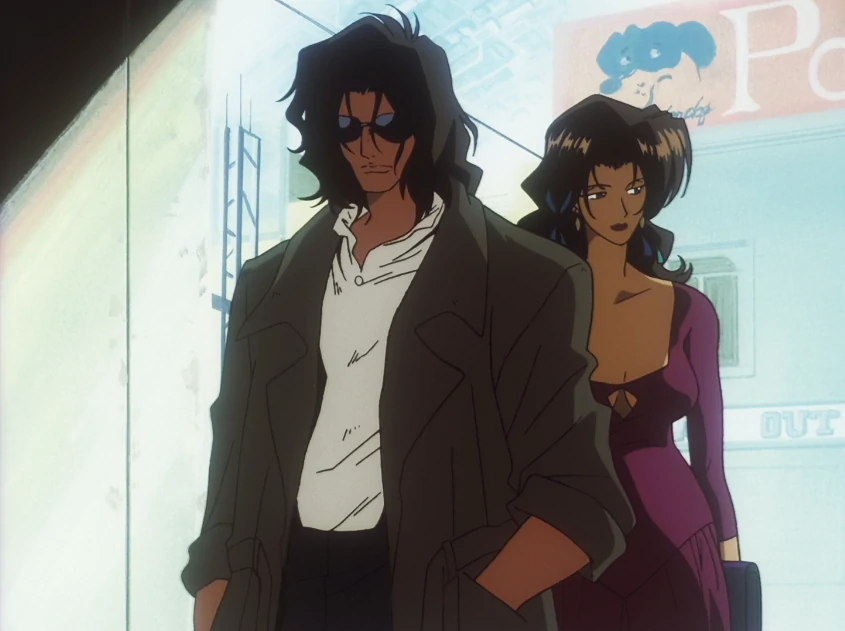
Tijuana, the setting of “Asteroid Blues”, is a small colony in the asteroid belt and the first of many memorable places we visit in Cowboy Bebop, drawing influence from Mexican and South American culture. The first place we stop into at the colony is a bar called the El Rey; it feels like an old-time western saloon stuck in the middle of a 21st-century city—there’s still the traditional hallmarks, such as the local old coots playing cards and a well-dressed but sleazy bartender, but there’s a jukebox instead of a piano player in the corner and modern amenities. It even culminates in a bloody shootout, after members of Asimov’s old syndicate find the pair there and fill the walls with bullets to try and retrieve the Bloody Eye, but Asimov has already taken some as a “demonstration” for the bartender and easily overpowers the syndicate’s goons.
Meanwhile, Spike is off visiting Laughing Bull—a Native American shaman who lives near the colony—to try and get some sense of where Asimov is, and Jet arrives at the bar moments after the shootout and Asimov’s escape. After getting some advice from the shaman as to where Asimov might be, Spike has to refuel his ship—and winds up running into Asimov and later Katerina. Spike seemingly doesn’t recognize Asimov and passes him by before running into Katerina and striking up a friendly conversation with her. It’s a surprisingly human moment for a show of its nature: Katerina talks about her dream of someday living on Mars, while Spike mentions that he was born there and jokes that he’s a traveling performer. But the conversation takes a turn for the worse when Katerina realises that Spike is a “cowboy” (the show’s term for bounty hunters), and Spike reveals that he knows she’s with Asimov and that he’s after the two of them, only for Asimov to get the drop on him and nearly choke him to death before the pair escape.
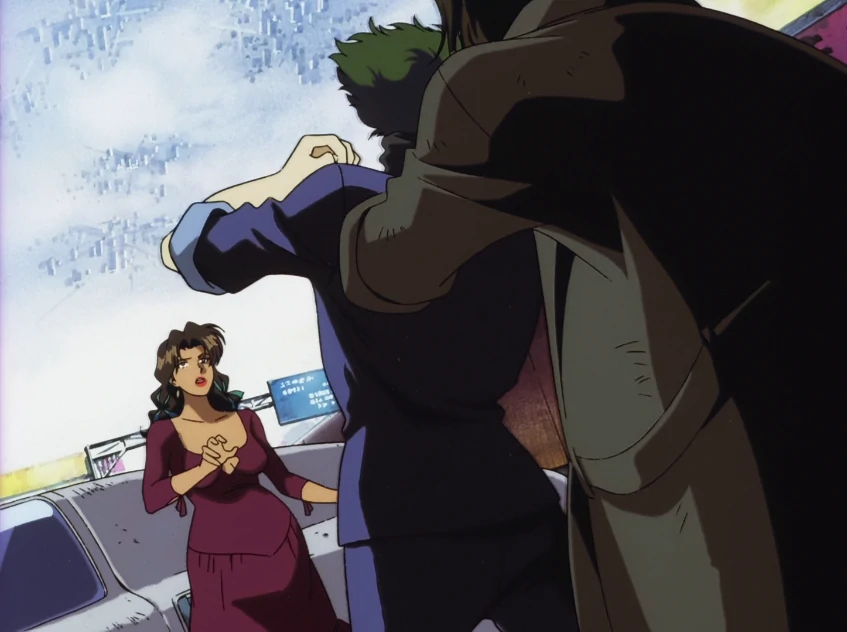
Later, Spike secretly arranges a meeting with Asimov under the pretense of purchasing some Bloody Eye, disguised in an outfit that’s an homage to The Man With No Name, Clint Eastwood’s character from Sergio Leone’s iconic spaghetti westerns—one of the first big homages to Western cinema and culture that we see throughout the show. When Spike reveals himself, it leads to the first of the series’ many, many fight scenes.
Fight scenes are practically an anime staple by this point, but Bebop sets its fights apart in two distinct ways. First, each fight is grounded in a solid sense of realism. These weren’t the over-the-top, multi-episode super-powered throwdowns of Dragonball Z, the fantastical magic-driven clashes of Sailor Moon, or the mecha battles of Voltron—these are gritty, dirty, hand-to-hand brawls closer to what you would find in a spaghetti western or a John Woo flick. Secondly, there’s the unique fight choreography and music. The Spike/Asimov brawl in “Asteroid Blues” is set to a jazzy, big band tune, and when you watch Spike, he comes across almost as more of a dancer than a fighter, seemingly moving in time with the music as he skillfully dodges Asimov’s punches before flooring him with a haymaker of his own. Asimov is clearly experiencing some bad side effects of his repeated use of Bloody Eye and it’s taking a toll on him, but this fight sequence is also a telling character moment that gives us one of our first hints at Spike’s past—he’s clearly been in many, many fights before, and it’s something that he’s quite good at.
But the fight is quickly broken up by both syndicate goons and the police moving in, forcing Asimov and Katerina to flee while revealing that her seemingly pregnant stomach was actually the stash of Bloody Eye. The pair hijack a spaceship in an escape attempt, but Spike quickly flies after them in pursuit.
Moral ambiguity also plays a heavy part in Cowboy Bebop, both with its main cast and often with their targets. Spike, Jet, and Faye aren’t necessarily good or bad, and they usually find themselves in the middle of conflicts with the police on one side and the crime syndicates on the other, just trying to get out alive and with enough money to keep the Bebop running. While we don’t know the full story of Asimov and Katerina’s pasts, when we meet them in “Asteroid Blues,” they’re trying to leave their pasts behind and set up a real life somewhere else—even if their way out is through selling a dangerous performance-enhancing drug.
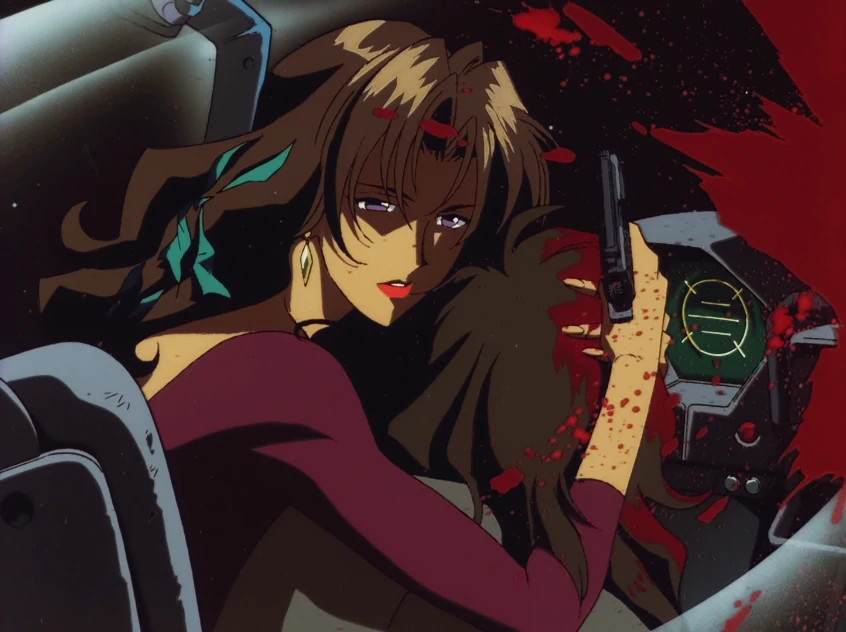
But even this spaceship chase doesn’t turn into anything bombastic—instead, the music here turns somber, and the focus is placed on Katerina pleading with Asimov to stop taking the Bloody Eye and telling him that “that stuff is going to kill you!”
But it’s too late. Asimov has used too much Bloody Eye for too long, and when he accidentally ingests a full vial, it drives him over the edge, causing him to manically steer their ship directly at the blockade of ISSP cruisers who are waiting. Katerina somberly realizes that she will never see Mars, and when Spike gets close enough to see the interior of their ship, Katerina is cradling Asimov’s lifeless body, having put a bullet in his head after refusing to cause any more destruction. Her eyes meet with Spike’s, and she manages one last “Adios” before her ship is blown to pieces by ISSP, leading to a hauntingly beautiful shot of her body floating in space, surrounded by debris and vials of Bloody Eye.
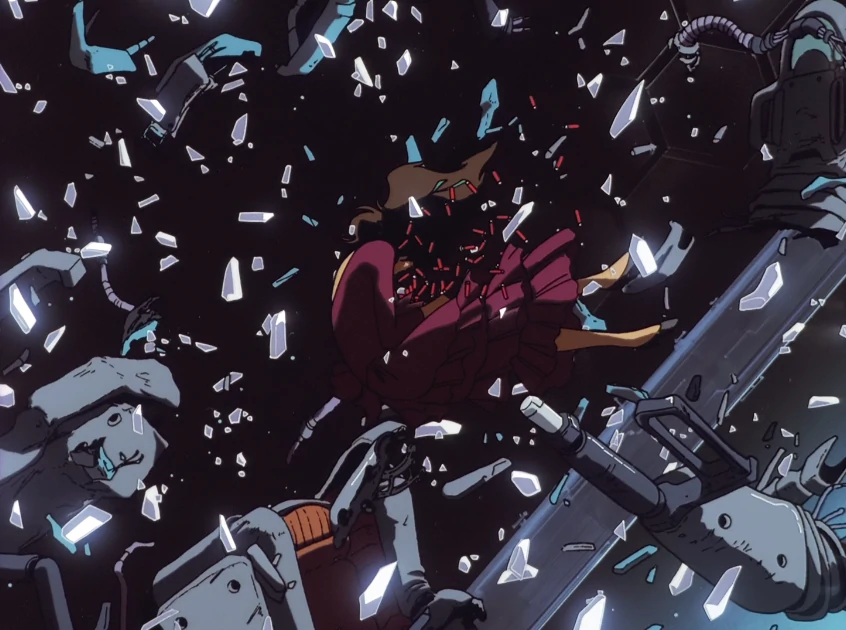
We end almost exactly where we started: Spike is practicing martial arts while Jet cooks dinner, but this time the bell peppers and beef actually has beef in it, and when Spike is done, he stares out the window of the Bebop into empty space, likely thinking of a girl who just wanted to see Mars. It’s an achingly human note to end the episode on before we get one last shot of the Bebop with the parting message that accompanies most sessions: “See You Space Cowboy.”
“Asteroid Blues” pulls off an impressive balancing act, functioning as both a self-contained story and as an introduction to the themes and overall style of Cowboy Bebop—and the show couldn’t have started on a better note.
See you indeed, Space Cowboy.


